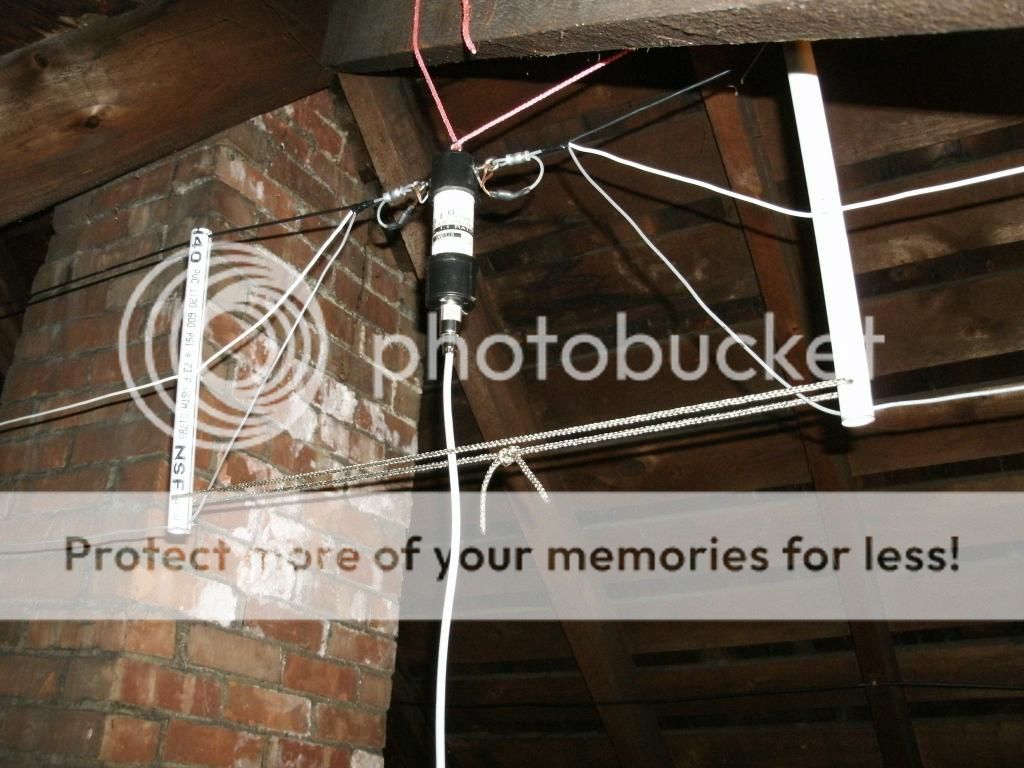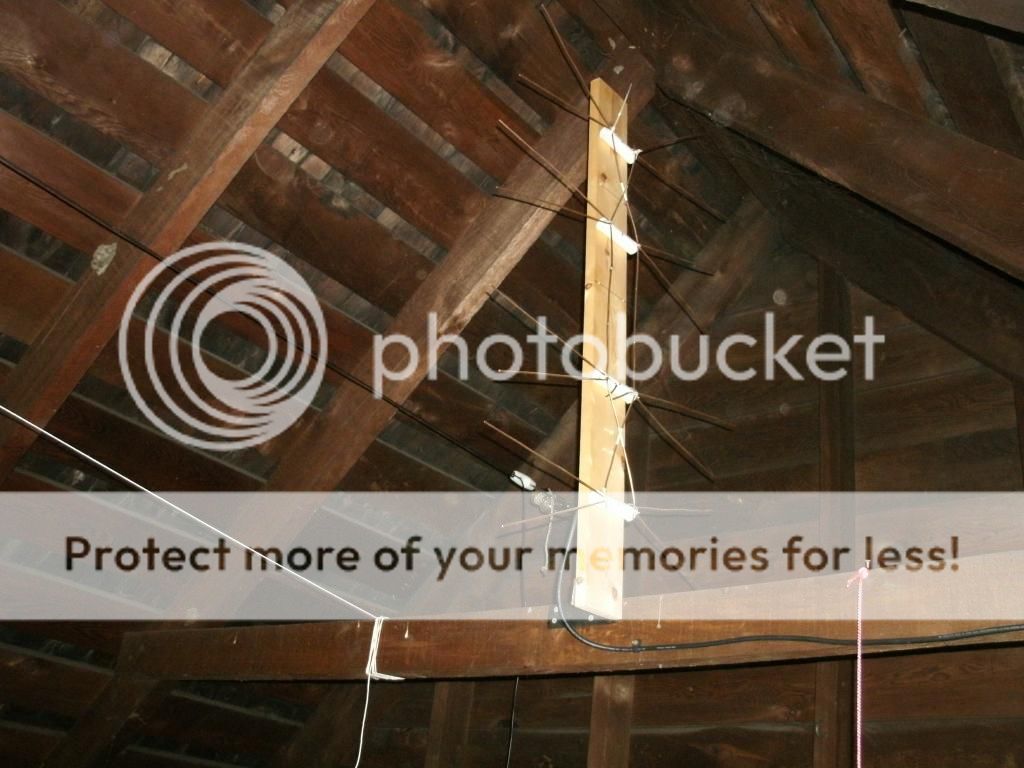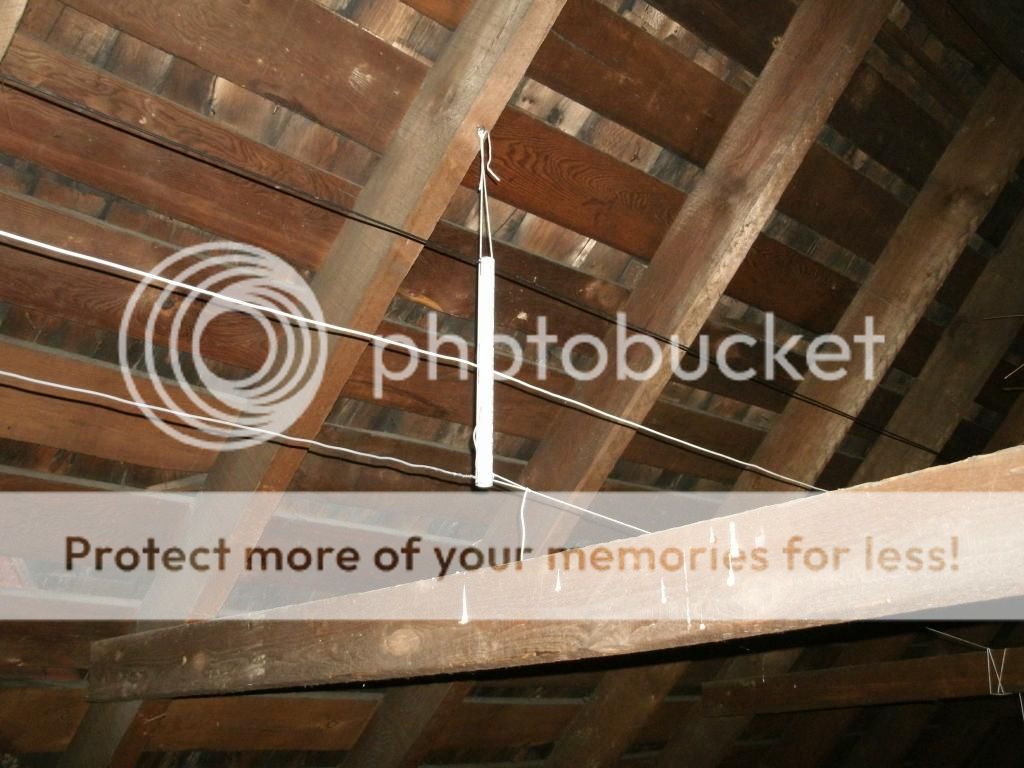You are using an out of date browser. It may not display this or other websites correctly.
You should upgrade or use an alternative browser.
You should upgrade or use an alternative browser.
-
You can now help support WorldwideDX when you shop on Amazon at no additional cost to you! Simply follow this Shop on Amazon link first and a portion of any purchase is sent to WorldwideDX to help with site costs.
-
A Winner has been selected for the 2025 Radioddity Cyber Monday giveaway! Click Here to see who won!
40/20/10 Meter Fan Dipole Attic Antenna
- Thread starter KD2GOE
- Start date
Interesting, 15 loads up on my 40 meter dipole without a tuner just fine. Do you use the tuner on 40?
i don't need to use the tuner on 40
In theory 15m will load nicely into a 40m dipole but as you said it depends on a few things. If all one looks at is SWR then you may be no where resonant on 40m where you need to be in order for the antenna to work on 15m. If you tune the antenna for true resonance and not simply lowest SWR then you stand a better chance of it working on both bands. Most people confuse low SWR with resonance but they are not the same thing.My experience has been that it is better to use separate antennas however.
well that's what i wanted in the first place, have 3 separate antennas shorten 80, 40 and 20 meter.. but my wife is still out of work and having all ready had all 3 antennas up there and only 1 run of coax for them the only option for me was to just combined them. the only money invested was 2.99 for the 1/2 PVC pipe..
when i first got it up and did a sweep with my analyzer i was surprised it was out side of the 15 meter band but being a fan antenna i expect the proximity to each antenna is making it do that.
doing the math the wires are the right size but keep in mind my 40 meter is all so bent 4' 90° on the ends.
Last edited:
I have too many hobbies I bought 2 dipoles with baluns for each. One is 11 meter the other 10 meter for when I go ham. I get perfect SWR on both. I have them in a horizontal ' V ' as I have it for DX. I will run a 10 meter base in the house and a 10 meter mobile and kicker when in the mobile. I Have my own house and land, where I park in back of my home. I have a quick disconnect for the mobile antenna when shopping. I am retired and don't travel much.i don't need to use the tuner on 40
well that's what i wanted in the first place, have 3 separate antennas shorten 80, 40 and 20 meter.. but my wife is still out of work and having all ready had all 3 antennas up there and only 1 run of coax for them the only option for me was to just combined them. the only money invested was 2.99 for the 1/2 PVC pipe..
when i first got it up and did a sweep with my analyzer i was surprised it was out side of the 15 meter band but being a fan antenna i expect the proximity to each antenna is making it do that.
doing the math the wires are the right size but keep in mind my 40 meter is all so bent 4' 90° on the ends.
Love it and it looks great BUT what's going on with your chimney?This is my attic 40/20/10 meter fan dipole that I installed in my attic today. In my opinion, it's a work of art! All I did was make spacers out of 1/2" PVC tubing the wire is spaced 6" off center. Then I combined my 40,20, & 10 meter antenna with a w2au balun that was part of my 10 meter antenna.
So far I am tuning around the bands and it is GREAT! Using my repaired MFJ-266 analyzer I am getting great SWR readings on 40,20,&10. I am able to tune 17, & 15 meters with my internal antenna tuner 12 meters is not happening but I can get that with my A99. I am going to get an IMax 2k in the spring to cover 10 and 12... for local talk



Someone beat me to the punch, but to reiterate - SWR does not tell us if the antenna is resonant, it only tells us what the feed line is doing!SWR for this antenna is
7.00Mhz @ 1.9:1 / 7.150 @ 1.4:1 / 7.3 @ 2.5:1 but reads 1.5 with my Rat shack and TS-2000 SWR meter
14.0mhz @ 2.2:1 / 14.175 @ 1.2:1 / 14.350 @ 2.0:1
28.0Mhz @ 2.2:1 28.530 @ 1.2:1 / 28.800 @2.0:1
The SWR meter in your Kenwood TS 2000 is not calibrated against anything and is not by any means accurate, nor is the Rat Shack meter...
What about field exposure limits - you are going to keep your power down under 100 watts aren't you?
Instead of worring about it being low SWR, why not do field exposure surveys and see how much of the power you produce is being radiated.
Last edited:
Love it and it looks great BUT what's going on with your chimney?
Yeah i dont know what is going on with that... Course correction i guess.
Someone beat me to the punch, but to reiterate - SWR does not tell us if the antenna is resonant, it only tells us what the feed line is doing!
The SWR meter in your Kenwood TS 2000 is not calibrated against anything and is not by any means accurate, nor is the Rat Shack meter...
What about field exposure limits - you are going to keep your power down under 100 watts aren't you?
Instead of worring about it being low SWR, why not do field exposure surveys and see how much of the power you produce is being radiated.
I used my MFJ Antenna analyzer readig. only one reading was done with radio shack meter... sorry i did not make that clear.. ill add all the info that the analizer gives me..
So your saying i cant use my 700 watt amp??
i am joking i am runnig an amp just 100 or less no amps...
Last edited:
I used my MFJ Antenna analyzer reading. only one reading was done with radio shack meter... sorry i did not make that clear.. ill add all the info that the analyzer gives me..
So your saying i cant use my 700 watt amp??
i am joking i am running 100 or less no amps...
Well you can if you want your kids and wife to get sick or be mutated or have problems with their pacemakers or vision...
Not to mention what it would do to your neighbors...
More than 100 watts into a dipole on 60m might make your heart stop.
I never saw a manufacturer make a 700 watt amplifier?
Frequently asked questions about the safety of radiofrequency (RF) and microwave emissions from transmitters and facilities regulated by the FCC
WHAT ARE "RADIOFREQUENCY" AND MICROWAVE RADIATION?
Electromagnetic radiation consists of waves of electric and magnetic energy moving together (i.e., radiating) through space at the speed of light. Taken together, all forms of electromagnetic energy are referred to as the electromagnetic "spectrum." Radio waves and microwaves emitted by transmitting antennas are one form of electromagnetic energy. They are collectively referred to as "radiofrequency" or "RF" energy or radiation.
The RF waves emanating from an antenna are generated by the movement of electrical charges in the antenna. Electromagnetic waves can be characterized by a wavelength and a frequency. The wavelength is the distance covered by one complete cycle of the electromagnetic wave, while the frequency is the number of electromagnetic waves passing a given point in one second.
The energy levels associated with RF and microwave radiation, on the other hand, are not great enough to cause the ionization of atoms and molecules, and RF energy is, therefore, is a type of non-ionizing radiation..
The quantity used to measure the rate at which RF energy is actually absorbed in a body is called the "Specific Absorption Rate" or "SAR." It is usually expressed in units of watts per kilogram (W/kg) or milliwatts per gram (mW/g). In the case of exposure of the whole body, a standing ungrounded human adult absorbs RF energy at a maximum rate when the frequency of the RF radiation is in the range of about 70 MHz. This means that the "whole-body" SAR is at a maximum under these conditions. Because of this "resonance" phenomenon and consideration of children and grounded adults, RF safety standards are generally most restrictive in the frequency range of about 30 to 300 MHz.
WHAT BIOLOGICAL EFFECTS CAN BE CAUSED BY RF ENERGY?
Biological effects can result from exposure to RF energy. Biological effects that result from heating of tissue by RF energy are often referred to as "thermal" effects. It has been known for many years that exposure to very high levels of RF radiation can be harmful due to the ability of RF energy to heat biological tissue rapidly. This is the principle by which microwave ovens cook food. Exposure to very high RF intensities can result in heating of biological tissue and an increase in body temperature. Tissue damage in humans could occur during exposure to high RF levels because of the body's inability to cope with or dissipate the excessive heat that could be generated. Two areas of the body, the eyes and the testes, are particularly vulnerable to RF heating because of the relative lack of available blood flow to dissipate the excess heat load.
Instead of worring about it being low SWR, why not do field exposure surveys and see how much of the power you produce is being radiated.
do you have the gear for that becuse i sure don't...
Yes, that equipment has been around practically as long as radio itself has.do you have the gear for that becuse i sure don't...
My very latest piece of equipment that I purchased at a hamfest for a grand total of $5.00 is a old Lafayette Citizens Band Transceiver Tester.
This is one of the exercises that a friend of mine was doing as a club project a while back.
Using simple math, since we know that all signals reduce at the square of the distance away. We can check antenna efficiency by measuring field strength at different distances. One variable is the soil moisture content. Good ground vs poor rocky soil is very important when you select any antenna site.
I have noticed that sometimes when a club moves their repeater from a poor location to what you would think would be a good location, their signal gets worse instead of better.
One example is a 2 meter repeater that was moved to the top of a large water tank.
The water tank was 50' higher then the repeater location and you would think that the metal structure under the antenna would act as a excellent ground plane, but the signal got worse instead of better. One theory was that the calcium deposits inside of the tank acted like an insulator.
We took our measuring equipment and found that the water tank was on rocky soil while the tower was on black dirt. The tower was 5 miles further away then the water tank, and yet the tower worked better as a repeater location then the tank...
There is computer models that you can use, along with technical data that comes with most commercially made antenna's that can produce a model of your antenna and predict your radiation pattern.
Anytime a person transmits with more then the allowable amount of power, they must do a field survey and they must keep a station record of both their activities and their field surveys..
2 meters - this is anything over 50 watts into a dipole.
70 cm - this is anything over 40 watts into a dipole.
That is the reason why most common mobile transceivers only produces 50 / 40 watts. That is your lesson for today!
The reason I use UHF and VHF is because most people only has a Technician Class License and most people can comprehend easier what a 2m or 70cm signal will do with 1 watt, 2 watts, 5 watts, 10 watts, 25 watts or 50 watts.
On HF - power is irrelevant. It is possible to operate on 10m phone with just 5 watts into a dipole antenna and be heard half way around the world.
Noise is inverse the square of the frequency.
The higher in frequency you go, the less noise you have to contend with...
This is the reason why 220 mhz is one of the best bands for working VHF DX or VHF contests. 220 has less noise then 2 meters, it propagates at times a little like 6 meters and it doesn't have as many users as even 70 cm, so you can find band openings that gives you meaningful contacts.
If you take a 50 watt. 2 meter, single side band signal and feed it with 100 feet of Belden 9913 coax into a 13 element beam antenna @ 65 feet. You have to use a link budget calculator to determine how many watts are scattered between the generator and the load.
The nominal attenuation is 1.4 db per 100' @ 100 MHz.
VSWR plays an important role, how many watts are absorbed and how many are reflected. Even at 65 feet, you won't have to content with neighbors bedroom windows or people walking around the antenna. The roof of the average home not being more than 40 feet off the ground.
Amplify this signal to 1000 watts and feed it into your 13 el beam and now you have problems with exposure limits..
A local man that I encouraged to upgrade his license from Technician to Amateur Extra became the President of two local amateur radio clubs. Along the way someone died and left him 30' of tower. He bought a 20m beam at a hamfest and because the guy was likeable, the local hams helped him put up his tower next to his house in the middle of the town.
The problem is - his neighbors house is only 25' away and his beam antenna is pointed directly at their bedroom window.
Had he put up two more sections of tower, at least his antenna would be above their roof. But if he operates with more then 100 watts - the exposure level at his QTH would be harmful to anyone sleeping in the neighbors bedroom.
The loss rate of the coax is much lower at 14 Mhz and the beam antenna amplifies the effect of the transmitter by focusing the energy in one direction.
This is why we have these rules.
Because idiots that doesn't know anything can get a license by passing a multiple guess test and then can operate equipment up to 1500 watts, that doesn't understand what it is that they are doing when they transmit.
On HF - power is irrelevant. It is possible to operate on 10m phone with just 5 watts into a dipole antenna and be heard half way around the world.
Noise is inverse the square of the frequency.
The higher in frequency you go, the less noise you have to contend with...
This is the reason why 220 mhz is one of the best bands for working VHF DX or VHF contests. 220 has less noise then 2 meters, it propagates at times a little like 6 meters and it doesn't have as many users as even 70 cm, so you can find band openings that gives you meaningful contacts.
If you take a 50 watt. 2 meter, single side band signal and feed it with 100 feet of Belden 9913 coax into a 13 element beam antenna @ 65 feet. You have to use a link budget calculator to determine how many watts are scattered between the generator and the load.
The nominal attenuation is 1.4 db per 100' @ 100 MHz.
VSWR plays an important role, how many watts are absorbed and how many are reflected. Even at 65 feet, you won't have to content with neighbors bedroom windows or people walking around the antenna. The roof of the average home not being more than 40 feet off the ground.
Amplify this signal to 1000 watts and feed it into your 13 el beam and now you have problems with exposure limits..
A local man that I encouraged to upgrade his license from Technician to Amateur Extra became the President of two local amateur radio clubs. Along the way someone died and left him 30' of tower. He bought a 20m beam at a hamfest and because the guy was likeable, the local hams helped him put up his tower next to his house in the middle of the town.
The problem is - his neighbors house is only 25' away and his beam antenna is pointed directly at their bedroom window.
Had he put up two more sections of tower, at least his antenna would be above their roof. But if he operates with more then 100 watts - the exposure level at his QTH would be harmful to anyone sleeping in the neighbors bedroom.
The loss rate of the coax is much lower at 14 Mhz and the beam antenna amplifies the effect of the transmitter by focusing the energy in one direction.
This is why we have these rules.
Because idiots that doesn't know anything can get a license by passing a multiple guess test and then can operate equipment up to 1500 watts, that doesn't understand what it is that they are doing when they transmit.
well this idiot is going to take his antenna down.
i don't think this is right hobby for me any way. out of the hand full of people i even talk to its just a contest or there just jackass... only 2 guys ever had the time to carey on a polite conversation...
i don't mind criticism but it seems a lot of it is all under assumption that i am banging out a ton of power and i am going to kill or hurt every one around my home. i fully understand the impact of RF exposure and even had to talk my friend out of running a 600w amp with his 40 meter dipole over his head.... i don't have time to go back and forth with you...
if you want to do a full right up and post your feelings on antennas and their proximity.. do it in a different thread. because right now all your doing is just relishing every thing i have read and prepared for when i took the test..
i don't think this is right hobby for me any way. out of the hand full of people i even talk to its just a contest or there just jackass... only 2 guys ever had the time to carey on a polite conversation...
i don't mind criticism but it seems a lot of it is all under assumption that i am banging out a ton of power and i am going to kill or hurt every one around my home. i fully understand the impact of RF exposure and even had to talk my friend out of running a 600w amp with his 40 meter dipole over his head.... i don't have time to go back and forth with you...
if you want to do a full right up and post your feelings on antennas and their proximity.. do it in a different thread. because right now all your doing is just relishing every thing i have read and prepared for when i took the test..
The test doesn't explain to you that what you are doing is essentially broadcasting.
It doesn't matter if it is 1 watt or 10,000 watts, we are all doing the same thing.
What the test does is give you a minimum amount of exposure to radio and electronics so at least you will know something.
The test was not designed to be any type of proof that you know anything about broadcasting or electronics.
It is what you do with your license, after you get your license that counts the most.
Some people runs attic dipoles for years and doesn't have a complaint in the world, while other people like me - doesn't like them and wouldn't put one up, even if I had to.
I would move before I would use a compromise antenna.
The point of the hobby is to talk to people and to have fun.
I get my most enjoyable conversations on 10m.
You can also get good conversation on CW.
40 meters is not the place to go to rag chew, unless you are part of a group of people that just hangs out on 40.
Most of those people - just like 2m are cliquish and they only want to talk to each other.
20m has a lot of nets and 80m has a lot of nets and rag chews - buddy clubs.
It doesn't matter if it is 1 watt or 10,000 watts, we are all doing the same thing.
What the test does is give you a minimum amount of exposure to radio and electronics so at least you will know something.
The test was not designed to be any type of proof that you know anything about broadcasting or electronics.
It is what you do with your license, after you get your license that counts the most.
Some people runs attic dipoles for years and doesn't have a complaint in the world, while other people like me - doesn't like them and wouldn't put one up, even if I had to.
I would move before I would use a compromise antenna.
The point of the hobby is to talk to people and to have fun.
I get my most enjoyable conversations on 10m.
You can also get good conversation on CW.
40 meters is not the place to go to rag chew, unless you are part of a group of people that just hangs out on 40.
Most of those people - just like 2m are cliquish and they only want to talk to each other.
20m has a lot of nets and 80m has a lot of nets and rag chews - buddy clubs.
dxChat
- No one is chatting at the moment.
-
dxBot:brandon7861 has left the room.
-
-
-
-
@ boniface95:Hi there, I just posted this question, if anyone has time to check it out, i'd really appreciate some feedback. https://www.worldwidedx.com/threads...-radio-transmitters-in-the-same-space.270736/


